The AMD Radeon R9 290 Review
by Ryan Smith on November 5, 2013 12:01 AM EST- Posted in
- GPUs
- AMD
- Radeon
- Hawaii
- Radeon 200
Overclocking
Finally, let’s spend a bit of time looking at the overclocking prospects for the 290. Without any voltage adjustment capabilities and with AMD binning chips for clockspeeds and power consumption we’re not necessarily expecting a lot of headroom here, but none the less it’s worth checking out to see how much more we can squeeze out of the card.
Even though we’re officially limited to AMD’s Overdrive utility for the moment for overclocking, Overdrive offers a wide enough range of values that we shouldn’t have any problem maxing out the card. In fact we’ll be limited by the card first.
| Radeon R9 290 Overclocking | |||
| Reference Radeon R9 290 | |||
| Shipping Core Clock | 662MHz | ||
| Shipping Boost Clock | 947MHz | ||
| Shipping Memory Clock | 5GHz | ||
| Shipping Boost Voltage | ~1.18v | ||
| Overclock Core Clock | 790MHz | ||
| Overclock Boost Clock | 1075MHz | ||
| Overclock Memory Clock | 5.6GHz | ||
| Overclock Max Boost Voltage | ~1.18v | ||
Despite the lack of voltage control, when it comes to overclocking the 290 we were able to achieve solid overclocks on both the GPU and the memory. On a boost clock basis we were able to push the 290 from 947MHz to 1075MHz, an increase of 128MHz (14%). Meanwhile we were able to push the memory from 5GHz to 5.6GHz before artifacting set in, representing a 600MHz (12%) memory overclock. Being able to increase both clockspeeds to such a similar degree means that no matter what the video bottleneck is – be it GPU or memory – we should see some kind of performance increase out of overclocking.
On a side note, for overclocking the 290 we stuck with moderate increases to both the maximum fan speed and the PowerTune limit. In the case of the former we used a 65% maximum fan speed (which actually proved to be more than what’s necessary), while for the latter we went with a 20% increase in the PowerTune limit, as at this point in time we don’t have a good idea for what the safe power limits are for the reference 290/290X board. Though in either case only FurMark could push the overclocked card to its power limit, and nothing could push the card to its fan speed limit. Similarly we didn’t encounter any throttling issues with our overclocked settings, with every game (including CoH2) running at 1075MHz sustained.
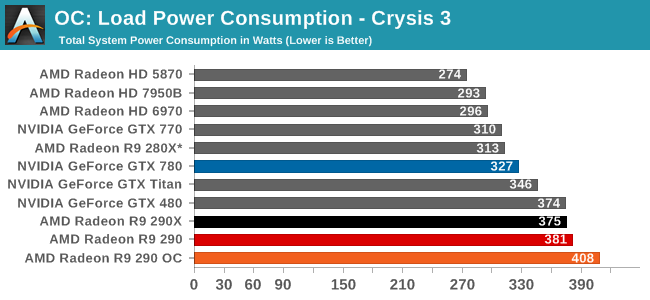
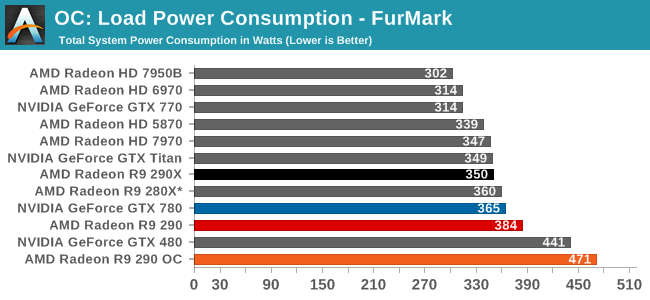
Taking a brief look at power, temp, and noise before jumping into our gaming performance results, we can see that overclocking the card has a measurable impact on power consumption under both Crysis 3 and FurMark. With Crysis 3 we’re clockspeed limited before we’re power limited, leading to an increase in power consumption of 27W, while under FurMark where we were power limited it’s a much more academic increase of 87W.
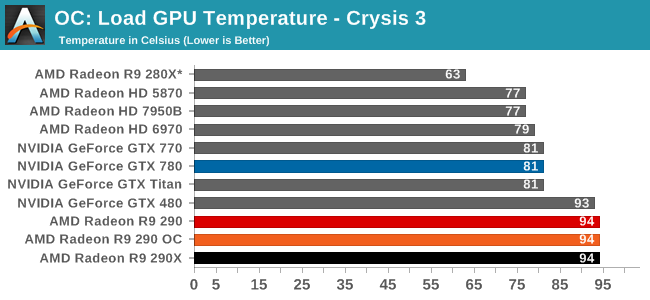
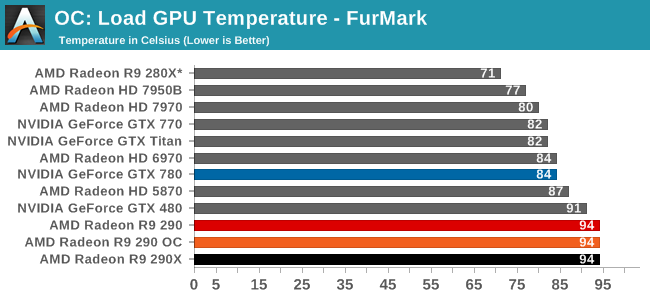
Since the 290 already ships at the highest temperate limit it allows – 95C – our sustained temperatures are unchanged even after overclocking.
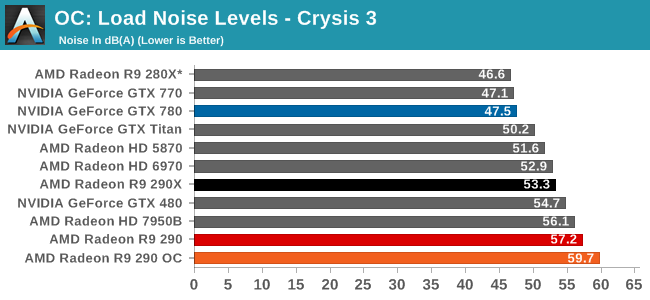
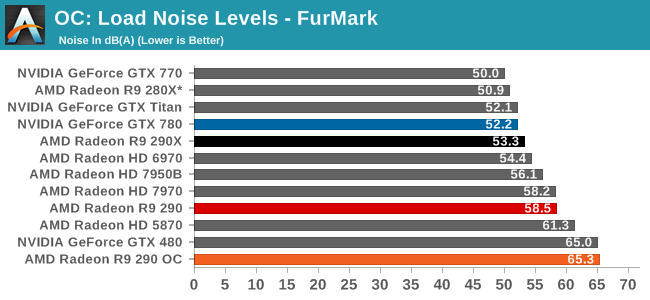
The 290 is already an unreasonably loud card at stock, and unfortunately the fan speed increases needed to handle the greater heat load from overclocking only make this worse. Under Crysis 3 we peaked at 59.7dB, or 49% fan speed. While under FurMark we peaked at 65.3dB, or 59% fan speed. For these noise levels to be bearable the 290 really needs to be fully isolated (e.g. in another room) or put under water, as otherwise 59.7dB sustained is immensely loud for a video card.
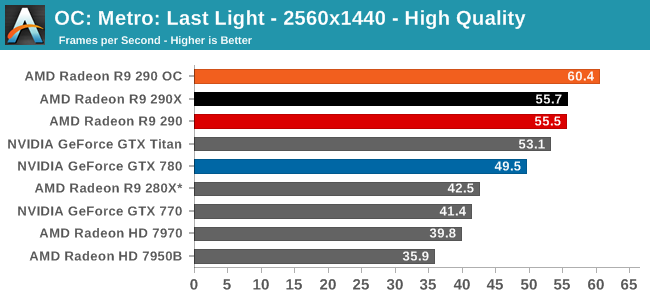
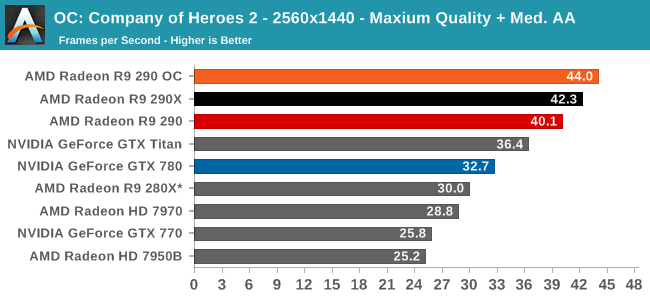
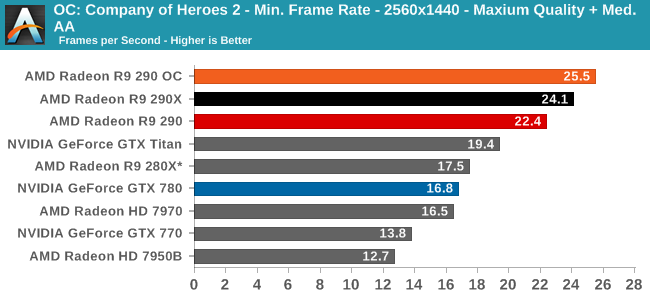
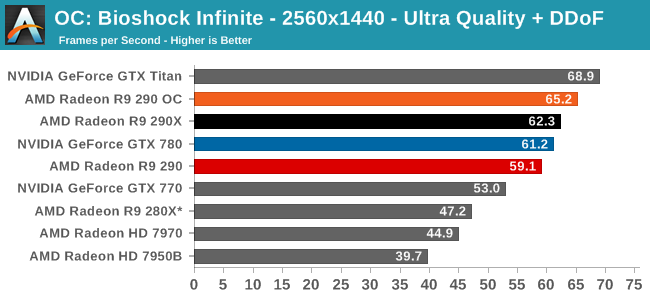
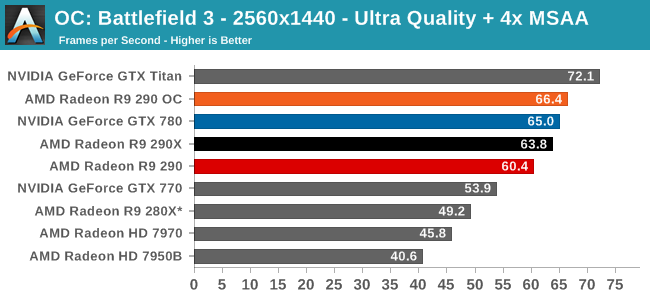
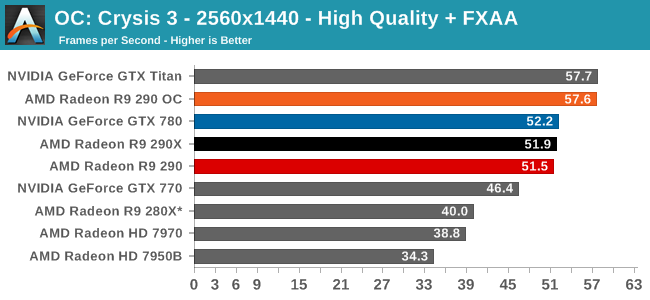
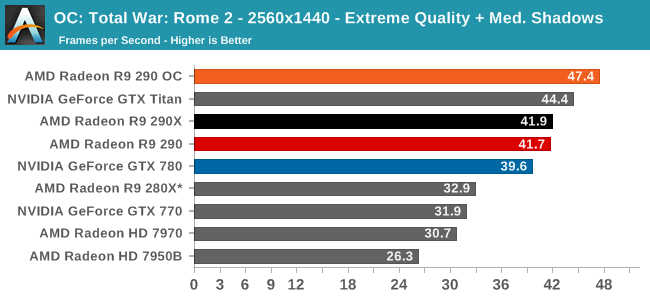
Finally getting to the matter of game performance, we’re seeing consistently strong scaling across every game in our collection. The specific performance increase depends on the game as always, but a 14% core overclock and 12% memory overclock has netted us anywhere between 9% in Metro up to the full 14% in Total War: Rome II. At this performance level the 290 OC exceeds the performance of any other single-GPU card at stock, and comes very close to delivering 60fps in every action game in our benchmark suite.










295 Comments
View All Comments
DMCalloway - Wednesday, November 6, 2013 - link
Not sure how to interpret your analogy. Heat is measured in watts (energy) needing dissipation. This card is running up to 95*C while drawing around 50 more watts of power than a 780 . The 780 while drawing 50 less watts of power is running up to 80*C. Out of the gate the heat sink on the R290 is going to have to be at LEAST 20% more effective than the current 780 heat sink, and this thermal excess is still being pumped into the case.Galidou - Friday, November 15, 2013 - link
Well as I can see you are rather unfamiliar with power leakage due to temperature... anyway I won't get into the subject, I'll let you google it. Getting a card to run a lot cooler at the same frequencies can reduces power usage depending on how bad it affects certain node.A 20 degree celsius difference can have a great impact on power usage which I think might turn the tide around. In 28nm design, power leakage has been a bigger problem than before, probably a reason why Nvidia has been using better reference coolers thus, enhancing the performance/watt for the last generations of video cards.
That is the basis of my previous analogy.
TrantaLocked - Tuesday, November 5, 2013 - link
With the card in the case, with headphones on, with sounds/music from the game playing, hearing the 290 or any card would be tough. I know what loud video cards sound like (I owned the 4890 with a single fan design, and I always ran the fan at manual 40%-50% speed for gaming), and when playing a game with headphones the sound is barely audible and definitely not distracting.Calinou__ - Tuesday, November 5, 2013 - link
I have a reference 570 in a sound dampened case and a headset and I can easily hear it, even at idle (40% fan speed)... and I guess the R9 290 is more noisy.Galidou - Tuesday, November 5, 2013 - link
A reference 570 if not cleaned regularly(once every two months) goes easily up to 62 db. GTX 480 went up to 64 db(brand new) and Nvidia fans praised it even if AMD fans were saying it was loud, nothing new in here... Nvidia fans once said that 64 db is ''nothing'' for a good performing card... Look at them now speaking and whining about the same situation, really fun to see the tides turn around...That was in a time when reference coolers where much more used and represented a MUCH bigger % of the market, I would never buy an AMD reference cooled card. Nvidia fans started to care about noise and temperature when they got the 600 series out and for the first time had an advantage.
Finally - Tuesday, November 5, 2013 - link
Whoever buys a card with the default fan? Get one with a custom design and problem solved. How hard is that?Aikouka - Tuesday, November 5, 2013 - link
Anyone that buys it right now? =Pkmmatney - Tuesday, November 5, 2013 - link
I used to think that too, until I actually bought a loud HD4890. I ended up having to get an Accelero, which made it dead quiet. My current NVidia based card is also really loud, but I fixed that buy underclocking it most of the time. Really loud cards are just not fun to deal with. I'd wait for third party cards to come out with better cooling solutions.hoboville - Tuesday, November 5, 2013 - link
Except that it's hot, noisy, and basically pointless to overclock because it's as loud as a medium party without music. So as it is, it's a bad card.However, since it's only $400, one could go out and buy a water cooling setup and have a card faster than the 290x for about the same or less money. For Titan money, you could get a second 290 and add some more rads to your setup. The thing is...if you do want to OC (and why wouldn't you with water cooling?), you'll have to dissipate over 800 watts of heat...
Slomo4shO - Tuesday, November 5, 2013 - link
Well done AMD. Competition at its finest!